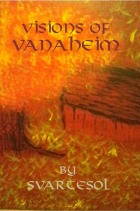 Visions of Vanaheim by Svartesól
Visions of Vanaheim by Svartesól
2008, Gullinbursti Press
566 pages
It is no secret that the modern Heathen revival has tended to be very Aesir-centric; even the term Asatru refers specifically to Odin, Thor, and their ilk, to the exclusion of their sibling family of gods, the Vanir.
The time is therefore more than ripe for the Vanic current in modern Heathenry to be given its due, and with Visions of Vanaheim Svartesól and a host of contributing authors have laid the foundations for the theological imbalance of contemporary Heathenry to be redressed.
The book is simply huge, and ranges widely over its subject matter. It provides detailed historical background on European cultures; explores a range of theories about the relationships of the two families of gods to history and one another; provides in depth discussions of a dizzying range of Vanic figures; offers extensive practical ideas for the realisation of what might be termed Vanatru in everyday life; and offers insightful and heart-felt accounts of Vanatruar and their relationships to their deities.
Svartesól sails a tight ship, and by and large this book gets a big tick for making it clear what claims are grounded in empirical evidence or mythological texts and what claims are speculative. This clarity is a considerable strength for the text, because it both enables the reader to draw their own conclusions (or launch into further research), and also affords an insight into the lived experience of a relationship with the Vanir.
In all honesty, this book almost certainly exceeds any equivalent text written for the sake of the Aesir, and Svartesól and her allies have thrown down a serious challenge in terms of quality and dedication. Anyone who had previously dismissed the Vanir will have to reconsider their careless attitude after reading this book: it is a wide-ranging, detailed, rigorous, and heart-felt presentation of the case for Vanatru.
I can’t say I agree with every opinion presented in this book, but in general Svartesól and her contributors are quick to clarify the terms of their perspectives so that if one disagrees, one at least feels that they are not trying to impose their views on the reader by means of misdirection and obscurantism (as some rather less honest authors in the area of Heathenry, and especially runes, have been known to do). As such, this book also represents a valuable contribution to the maturing and deepening of Heathen theology and spiritual thought.
Complaints? An index would have made it a lot more user-friendly – there is so much information packed into this book that it could easily be used as a reference text, but the lack of index impairs that somewhat.
I consider this book to be essential reading for all modern Heathens: for those drawn to the Vanir, this is the foundational text for modern Vanatru; for the rest, this book goes a long way to redressing the strong imbalance in emphasis between Aesir and Vanir in contemporary Heathenry.









Leave a Reply